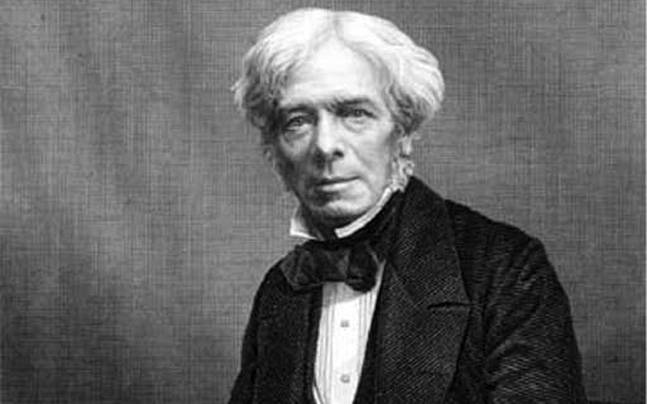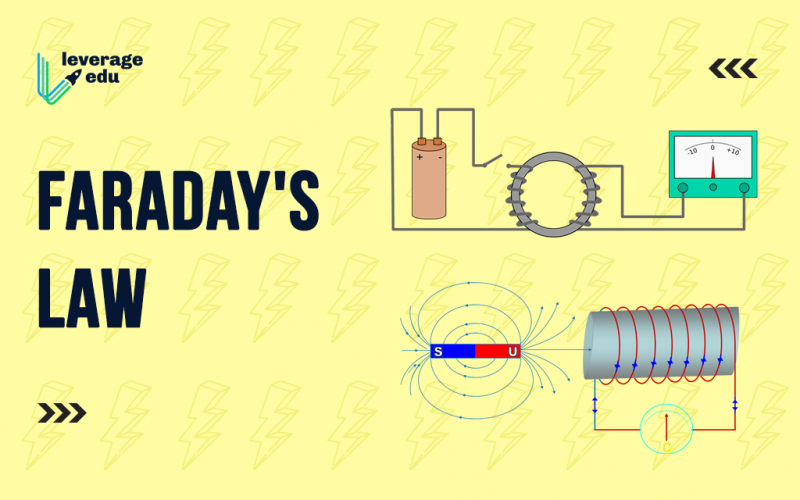Faraday’s law of induction (or Faraday’s law) is a basic law of electromagnetism predicting how a magnetic field will interact with an electric circuit to generate an electromotive force (EMF)—a phenomenon called electromagnetic induction. It is the fundamental operating principle of transformers, inductors, and many types of electrical motors, generators, and solenoids. In this article, we bring to you everything you need to know about Michael Faraday’s Law and how it is used to determine the induced electro-motive force. Read below to know more!
Who was Michael Faraday?
Before straightway jumping onto explaining Faraday’s law, let’s know about the man (Michael Faraday) who came up with this revolutionary law in the world of science. Michael Faraday was a British chemist and physicist who made substantial contributions to the fields of electrochemistry and electromagnetic. He was born in south London on September 22, 1791. Faraday was born into a poor family and acquired just a minimum formal education. He was apprenticed to a local bookbinder when he was 14 years old, and for the next seven years, he schooled himself by reading books on a variety of scientific subjects. Faraday attended four lectures at the Royal Institution in 1812 delivered by chemist Humphry Davy. Faraday then wrote to Davy, requesting a position as his assistant.

Davy rejected him, but in 1813 he was hired as a chemical assistant at the Royal Institution. Faraday was invited to join Davy and his wife on an 18-month European tour, which included visits to countries like France, Switzerland, Italy, and Belgium, as well as meetings with a number of notable scientists. Michael Faraday continued to work at the Royal Institution once they returned in 1815, assisting Davy and other scientists with research. His study on electromagnetic rotation was published in 1821 (the principle behind the electric motor). He then established the Royal Institution’s Friday Evening Discourses in 1826.
Michael Faraday discovered electromagnetic induction, the mechanism that underpins electric transformers and generators, in 1831. He focused on developing his concepts on electricity for the rest of the decade. Many well-known terminologies were coined as a result of his work, including ‘electrode,’ ‘cathode,’ and ‘ion.’ Through numerous government roles, such as scientific adviser to Trinity House (1836-1865) and Professor of Chemistry at the Royal Military Academy in Woolwich (1830-1851), Faraday’s scientific knowledge was put to practical use.
Did you know: The term ‘farad’ was used by Michael Faraday to describe a unit of electrical capacitance that was initially used to describe a unit of electrical charge.
Electromagnetic Induction
The process by which current can be induced to flow due to a changing magnetic field is known as electromagnetic induction. A classic example is a force on a current-carrying wire due to the electrons which move within it in the presence of a magnetic field. This process can also work in reverse order. Either of both, moving a wire through a magnetic field or altering the strength of the magnetic field over time, can lead to current flow.
How is it Described?
Electromagnetic induction is described by two key laws:
What is Faraday’s Law in Physics?
Given by the 19th-century physicist Michael Faraday. It links the rate of change of magnetic flux through a loop to the magnitude of the electromotive force.
E = dt/dΦ
The electromotive force or EMF is the potential difference across the unloaded loop, i.e. when the resistance in the circuit is high. In practice, it is more often than not adequate to think of EMF as voltage since both voltage and EMF are measured via the same unit, i.e., the volt.
Lenz’s Law
It is the result of energy conservation applied to electromagnetic induction. This was formulated by Heinrich Lenz in the year 1833. While Faraday’s law tells the magnitude of the EMF that is produced, Lenz’s law tells the direction in which the current will flow. The law states that the direction is always such that it will oppose the change in flux that produced it. This implies that any magnetic field that is produced by an induced current will be in the opposite direction to the change in the original field. It is typical to incorporate Lenz’s law into Faraday’s law with a minus sign, the inclusion of which allows the same coordinate system to be used for both the EMF and flux. The product is sometimes called the Faraday-Lenz law.
E = – dt/dΦ
In practice, magnetic induction is often dealt with in multiple coils of wire each of which contributes to the same EMF. For this reason, an additional term NNN representing the number of turns is often involved, i.e.
E = −N dt/dΦ
Connection Between Faraday’s Law of Induction and the Magnetic Force
While the complete theory of Faraday’s law is complicated, a conceptual understanding of the direct connection to the magnetic force on a charged particle is relatively simple.
For instance, take an electron that is free to move within a wire. The wire is, then, placed in a vertical magnetic field and moved perpendicular to the magnetic field at a constant velocity. Both ends of the wire are linked to form a loop. This is done to ensure that any work done in generating current in the wire is dissipated as heat in the resistance of the wire. A person pulls the wire through the magnetic field. As they do this, they have to apply force. The constant magnetic field cannot work by itself, but it can change the direction of a force. In this case, some of the force that the person applies is re-channelled which causes an electromotive force on the electron traveling in the wire, establishing a current. Some of the work the person has done pulling the wire ultimately leads to the energy dissipating as heat within the resistance of the wire.
Also Read: Branches of Physics and Definitions
Faraday’s Experiment: Induction From a Magnet Moving Through a Coil
The experiment which led Michael Faraday to determine Faraday’s law was simple. It can be easily replicated with little more than household materials. Faraday had used a cardboard tube with insulated wire wrapped around forming a coil. A voltmeter was linked across the coil and the induced EMF read as a magnet was passed through the coil.
The observations were as follows:
- Magnet at rest in or near the coil: No voltage observed.
- The magnet moving toward the coil: Some voltage measured, rising to a peak as the magnet nears the center of the coil.
- Magnet passes through the middle of the coil: Measured voltage quickly changes sign.
- Magnet passes out and away from the coil: Voltage measured in the opposite direction to the earlier case of the magnet moving into the coil.
The above observations are consistent with Faraday’s law. Although the stationary magnet might produce a large magnetic field, no EMF can be induced because the flux through the coil is unchanging. When the magnet nears the coil the flux quickly increases until the magnet is inside the coil. As it passes through the coil the magnetic flux begins to decrease. As a result, the induced EMF is reversed.
Also Read About: The Best Scientific Discoveries of the Year!
Applications of Faraday’s Law
The electromagnetic enlistment standards can be applied in various gadgets just as frameworks. A portion of the electromagnetic enlistment models incorporates the accompanying.
- Transformers
- Enlistment engines
- Electric generators
- Electromagnetic shaping
- Corridor Effect meters
- Current Clamp
- Enlistment cooking
- Attractive stream meters
Also Read: BSc Honours Physics
Subsequently, this is about Electromagnetic acceptance. It is a strategy where a conductor is situated inside a fluctuating attractive field which will cause the development of a voltage across the conductor. This will cause an electrical flow. The standard of electromagnetic enlistment can be applied in various applications like transformers, inductors, and so on This is the establishment of a wide range of electric engines and generators which can be utilized for creating power from power movement.
Faraday’s Law of Electromagnetic Induction
Michael Faraday’s Major Contributions to Science
Now that you are well versed with Faraday’s law of induction, let’s enlighten you with some of the major and prominent achievements or contributions made by Michael Faraday in the field of Science, which includes his inventions, discoveries and monumental research in electromagnetism:
- Michael Faraday invented the first electric motor in 1822, a rudimentary device capable of converting electrical energy into mechanical energy. His device, known as a homopolar motor, was only effective for demonstration reasons. It was, however, the first step in the development of the incredibly useful electric motor.
- Michael Faraday rose to fame as a chemist in his early years, especially when he invented the first known carbon-chlorine compounds, hexachloroethane and tetrachloroethene in 1820. He extracted and identified benzene from the oily residue left over from lighting gas manufacturing in 1825. The discovery of benzene by Faraday was crucial since benzene is one of the most important chemicals.
- All gases, according to John Dalton, might be liquefied. For the first time, Michael Faraday demonstrated this truth by using pressure to liquefy chlorine and ammonia gas.
- Faraday’s most famous experiment was wrapping two wires around the opposite ends of an iron ring in 1831. He hooked one wire to a galvanometer and kept an eye on it while connecting the other to a battery. A transient current was produced when he connected and detached the wire from the battery, which could be observed in the galvanometer. The shift in magnetic flux that happened when the battery was connected and disconnected caused this induction. As a result, it was an example of electromagnetic induction.
- By revolving a copper disc between the poles of a horseshoe magnet, Michael Faraday devised a device that could produce a constant (DC) current. This was the first electromagnetic generator or device that transforms mechanical energy to electrical energy. It was known as the Faraday disc. It was also where modern dynamos, the first electrical generators capable of supplying power to industry, had their start.
- He developed the Faraday Cage, an enclosure that blocks electric fields, using the theory of electrostatic shielding he discovered. Faraday cages are still employed for a variety of applications, including lightning protection and the creation of dead zones for mobile communications.
- Michael Faraday observed in 1845 that a magnetic field rotated the plane of polarisation of light, and that the angle of rotation was related to the strength of the magnetic force. The Faraday Effect or Faraday Rotation is the name for this phenomenon.
That was all about Faraday’s Law. We hope that the blog must have provided you with loads of exciting information and facts. For more such informative content, stay tuned with Leverage Edu! You can connect with us on Instagram, Twitter, Facebook, Linked In, and YouTube & also subscribe to our newsletter.

 One app for all your study abroad needs
One app for all your study abroad needs
























 45,000+ students trusted us with their dreams. Take the first step today!
45,000+ students trusted us with their dreams. Take the first step today!


